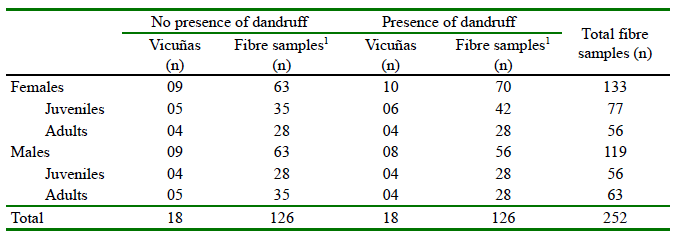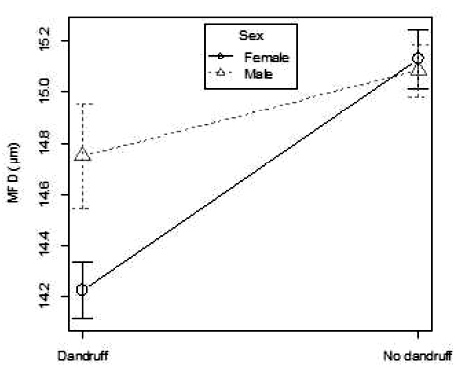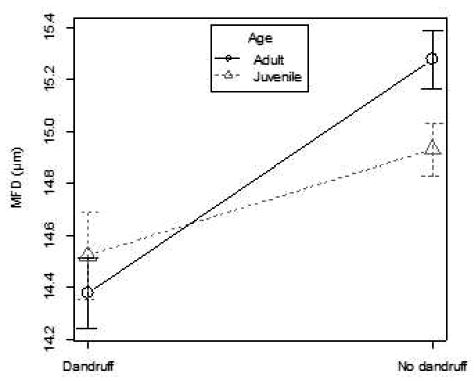INTRODUCTION
The vicuña is the smallest member of the Camelidae family with one of the most valuable fibres in the world. In the Andean region there are two subspecies of vicuñas, distinguished mainly by their genetic, size and fibre tonality (Marín et al., 2018; González et al., 2019). They are distributed upon two geographical regions, Vicugna vicugna mensalis inhabits in the north-centre of South America, while the austral vicuñas (Vicugna vicugna vicugna) are mainly present in the south (González et al., 2019; González & Donoso, 2020). The fleece of vicuña has a double coat, about 2% of coarse outer guard hairs with no commercial value and a finer undercoat of high commercial value present in highest proportion (Pinares & Yauri, 2019; Chamut et al., 2016; Carpio & Solari, 1982).
In Perú, the mean fibre diameter of vicuña ranges from 10.5 to 15 ìm (Carpio & Solari, 1982; Quispe et al., 2014; Quispe et al., 2018; Pinares & Yauri, 2019). The textile quality of vicuña fibre shows high value compared with other animal fibres (McGregor, 2018; Hunter, 2020). According to Kasterine and Lichtenstein (2018) in the period 2017, the international trade of dehaired fibre has been quoted at US$ 1450.00/kg, pre-dehaired fibre at $450.00/kg and as dirty fibre at $420.00/kg; while in the Peruvian market the price of dehaired and dirty fibre were of $715.00 and $270.00/kg, respectively.
The scabies and dandruff adversely affect the commercial value of vicuña fibre. The first is controlled with macrocyclic lactones, but dandruff has only recently been characterized. Dandruff is a very common scalp condition characterized by flaking and pruritus with no visible signs of inflammation. According to the integrated approach of "One World, One Health", dandruff severely affects the health and welfare of the individuals. Dandruff appears as scales attached to fine fibres, which begins especially on the back and extending to the ventral region (Rosadio et al., 2012).
On the other hand, dandruff affects the individual fibres of vicuñas making it difficult to process it for textiles and that in advanced cases visibly affects the skin health of the vicuña (Flores et al., 2021). Some vicuñas at the time of shearing present small scabs almost all over the fleece (Rosario et al., 2012), which cannot be separated at the time of washing. The punctual prevalence of dandruff reaches 10.54% in the population of vicuñas from Huancavelica region (Chacón, 2021) and higher in other regions. In Tungurahua, Ecuador, 13 fleeces with dandruff were found from 57 sheared vicuñas, representing 21.2% (Zúñiga et al., 2018). The fleeces affected with dandruff are reject by traders, which means a great loss in the economy of peasant families that are dedicated to the management and conservation of vicuñas. The textile quality of vicuña fibre affected with dandruff has not been previously characterized. Thus, the aims of this research were to characterize the presence of dandruff in the vicuña and to determine the influence of dandruff on the six main textile characteristics of vicuña fibre by sampling site, age and sex.
MATERIALS AND METHODS
Ethics Statement
The collection procedure of fibre samples was approved by the Ethics Committee of the National Universidad Nacional San Antonio Abad del Cusco (CBIUNSACC) modified by N.° 079-2021-CUUNSAAC, in accordance with the Peruvian Law N.° 30407 "Animal Protection and Welfare Law".
Location
The study was carried out in the sector of Rafael Pampa of San Miguel de Mestizas Peasant Community located in the central Andes of Peru, between 4200 and 4700 meters above sea level. The area has slopes, small valleys and rocky hills, and contains small water holes, as well as small lagoons in the rainy season. The vicuñas are reared under a semi-captivity management, grazing plant species such as Alchemilla pinnata, Trifolium amabile, Stipa braciphylla, Calamagrostis curvula, Calamagrostis sp. Calamagrostis vicunarum, Poa gilgiana, Paspalum pigmaeum, Bromus sp, Carex sp, Festuca huamachusensis, Poa sp, Stipa mucronata, Disticha muscoides, Muhlenbergia fastigiata y Hipochaeris taraxacoides.
Chaku of Vicuñas
The vicuñas were captured following the ancient technique developed by the Incas, which consisted of people (men and women) walking with ropes to drive thousands of vicuñas into large corrals. The health status and the presence of dandruff on the fleece were examined before shearing. Affected animals and baby vicuñas were not sheared.
Population Structure and Fleece Sampling
The population structure was determined through the number of captured vicuñas and shearing cards registered during the 2017, 2018, 2019 and 2021 periods of chaku. The number of captured vicuñas ranged from 2023 to 2581. In 2017, 68% adults, 12% juveniles and 20% baby vicuñas were captured, and the proportion of vicuñas sheared was 27.8% obtaining 87 541 kg of fibre. In 2018, the proportion of vicuñas sheared with respect to those captured was half of previous period (14%) obtaining only of 57 331 kg of fibre, being the decrease of fibre production probably linked to the incidence of dandruff. In 2019, the shearing rate reached 30.3%, harvesting 98 904 kg of fibre, while shearing was interrupted by SARS-CoV-2 in 2020. In this context, in 2021, the shearing rate increased to 35.7% of vicuñas, harvesting 133 406 kg of fibre.
Probabilistic sampling method was used to determine the sample size, assuming an alpha error of 0.05 with a statistical power of 95%, precision of 1.1 µm, variance = 1.99 and SD = 1.41 (Pinares & Yauri, 2019). Considering the sex and age, sample size resulted in 36 vicuñas (18 affected with dandruff and 18 unaffected) sheared using an electrical shearing machine. On this, 252 fibre subsamples (Table 1) from seven sites of fleece from the right side were obtained, following the cranio-caudal and dorso-ventral orientation (Figure 1): lower neck (LN), anterior saddle (AS), central saddle (CS), rump (RU), thigh (TH), belly (BE) and arm (AR).
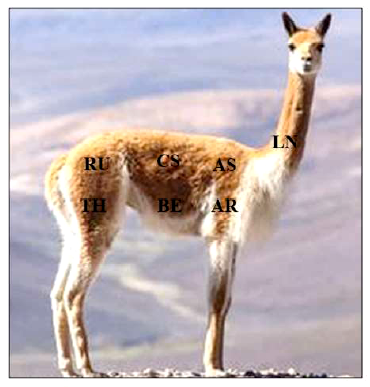
Figure 1 Sampling site of fleece: lower neck (LN), anterior saddle (AS), central saddle (CS), rump (RU), thigh (TH), belly (BE) and arm (AR).
Dandruff Identification and Fibre Quality Analysis
In 2017 and 2021, direct observations were done of the presence of dandruff on the fleece of each vicuña in the standing animal or when the vicuña was lying on the shearing beach held by the shearer's assistants. The observation was done quickly in standing animals due to their nervousness, while in lying animals it was possible to describe the characteristics and distribution of dandruff in the animal's body and the physical state of the animal with dandruff, recording what was observed in photographs that were attached in the results section. The punctual prevalence of dandruff was estimated with the formula: punctual prevalence = (cases of dandruff/population of vicuñas) x 100.
Dandruff evaluation in individual fibres was carried out by microscopic and visual observations. The fleeces with dandruff were spread on a table to accurately describe the epithelial flaking. Fibre measurements were recorded: mean fibre diameter (MFD), standard deviation of MFD (SD), coefficient of variation of MFD (CV), percentage of fibres <30 ìm (comfort factor, CF), spinning fineness (SF) and mean fibre curvature (CU). Optical fibre diameter analyser (OFDA 2000) was used in the Fibre Laboratory of the National University of Huancavelica, following the IWTO: 47 procedures (IWTO: 47, 2007).
Statistical Analysis
Six textile characteristics of fibre (MFD, SD, CV, CF, SF and CU) were analysed using the following linear model: Yijklm = µ + Di + Sj + Ak + Fl + eijklm, considering the presence of dandruff (Di), sex (Sj), age (Ak) and fleece sampling site (Fl). Additionally, in the linear model, double interactions were included as fixed effects. Least squares mean adjusted with Tukey-Kramer (α=0.05) was used to compare mean values. Likewise, the mean plot complemented the statistical analysis. Phenotypic correlations among fibre textile characteristics were calculated. The R software was used (R Core Team, 2021) to perform these analyses, statistical computing and graphics.
RESULTS AND DISCUSSION
In 2017, 20.55% of vicuñas had dandruff (423 out of 2058) and in 2021 increased up to 22.97% (593 out of 2581). These results are higher than 9% reported by Flores et al. (2021) in vicuñas managed in wild conditions in Ayacucho, 10.53% reported by Chacón (2021) in Huancavelica, and similar to 21.2% reported by Zúñiga et al. (2018) in Arenal (Ecuador).
These results are cause for concern and could have two possible explanations: the largest population of vicuñas in 1000 ha under semi-captive management conditions affects the adequate nutrition due to sometimes overgrazing, aggravated by low availability of water in the area. Poor wildlife management conditions could increase the incidence of dandruff in vicuñas. Besides, imbalance of minerals like copper, zinc and selenium are related to dandruff (Rosadio et al., 2012). Flores et al. (2021) suggested that the overgrazed native prairie would not be covering the nutritional needs in minerals and vitamins. These negative points require further studies and seeing the possibility of reducing the current population of vicuñas.
The general condition and behaviour of affected vicuñas with dandruff were apparently similar to that of the vicuñas without dandruff, as reported by Rosadio et al. (2012), however, these conditions are masked because the stress of the animals during the capture and shearing. According to the One World One Health approach, the presence of dandruff in vicuñas probably affects their behaviour and welfare, because it is known that discomfort, itching and burning sensations are common in humans (Ranganathan & Mukhopadhyay, 2010). Dandruff was observed on the fibre as skin epithelial flakes, in various forms of small greyish-white particles closely adherent to the fibre, some flakes detach from the fibre (Figure 2). The skin appears very dry, so it would be classified as atypical dermatitis in vicuña skin. On the other hand, Flores et al. (2021) reported lesions with hyperkeratosis in the stratum corneum, with pictures of parakeratosis, orthokeratosis and acanthosis at the level of the germinative layer of the epidermis.
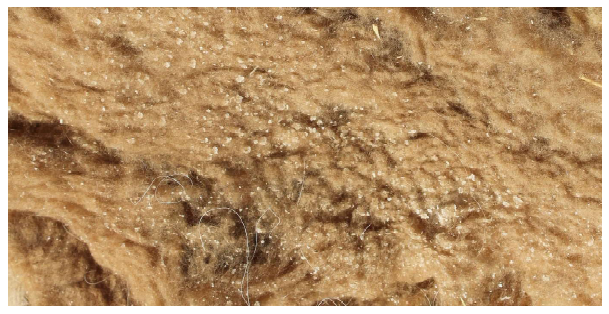
Figure 2 Vicuña fleece with presence of dandruff. The size and abundance of scales are heterogeneous among sites
Large volumes of fibre with dandruff (85 kg) were not sheared because the presence of dandruff. In relation to body parts, the presentation was more prominent on the head, followed by the back (Figure 3), shoulders, belly and rump. These forms of presentation resemble those reported by Chacón (2021), Rosadio et al. (2012) and Zúñiga et al. (2018).
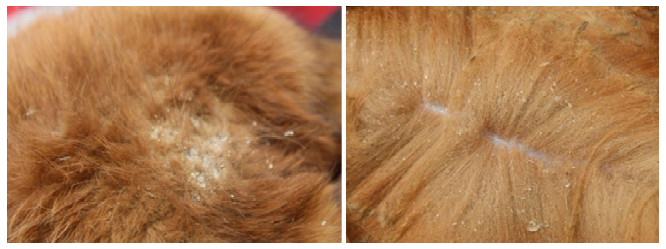
Figure 3 Presence of grayish-white epithelial scaling on fibre and skin of head (left) and back (right) in vicuñas affected by dandruff
The MFD in fleeces with and without dandruff was 14.48 and 15.11 µm, respectively. The values of SD, CF, SF and CU are notably reduced in the fibre affected with dandruff (Table 2). In real terms, fibres with dandruff are not suitable for textile processing due to the difficulty of removing through traditional washing (Zúñiga et al., 2018). Dandruff also weakens the physical structure of the fibre, reducing tensile strength, apart from the histological skin lesions described by Flores et al. (2021). Dandruff increases the mean fibre curvature (p<0.05), in fibres without dandruff the mean curvature was around 80°/mm similar to values reported by Quispe et al. (2010, 2011), while in fibres with dandruff this value was >85°/mm.
Table 2 Least squares mean ± standard error of mean fibre diameter (MFD), standard deviation of MFD (SD), coefficient of variation of MFD (CV), percentage of fibres <3 0µm (CF), spinning fineness (SF) and mean curvature (CU) in fleeces of vicuña with presence and absence of dandruff according to sex and age
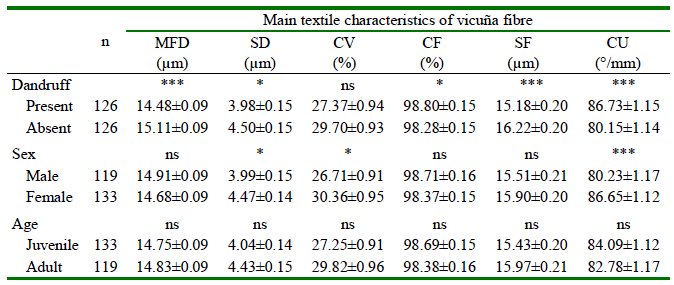
n: Number of fibre samples; *** p<0.001; ** p<0.01; * p<0.05; ns: no significant
The effect of sex was observed on the SD, CV and CU of fibre (Table 2), being the lowest values in males. However, no sex differences due to sex have been reported in fibre without dandruff (Quispe et al., 2011; Olaguivel-Flores et al., 2018). Age was not a factor affecting fibre characteristics as indicated by Pinares and Machaca (2022); however, other studies that did not consider the presence of dandruff, indicate differences in fibre quality between juveniles and adults (Olaguivel-Flores et al., 2018; Pacheco et al., 2019; Pinares & Yauri, 2019).
The MFD showed significant differences among the sampling sites (p<0.05), being thinner in anterior, central saddle and rump, with a noticeable thickening in lower neck, arm, thigh and belly (Table 3; Figure 3). Carpio and Solari (1982) reported a similar pattern in 12 fleece sites: 13.4 µm in the lower neck and 14.7 µm in the arm and leg. Quispe et al (2014) also showed similar MFD variability throughout the vicuña fleece. The fibre thickening pattern was only observed in the neck and the outer edges of the mantle such as the belly and the extremities. Various authors (Trejo et al., 2009; Quispe et al., 2014; Chamut et al., 2016) agree that the MFD is smaller in the saddle and maintains its homogeneity, while it increases up to 35 µm in belly and extremities of the body (Chamut et al., 2016).
Table 3 Least squares mean ± standard error of mean fibre diameter (MFD), standard deviation of MFD (SD), coefficient of variation of MFD (CV), percentage of fibres <30 µm (CF), spinning fineness (SF) and mean curvature (CU) by sampling sites of vicuña fleece (n=36)
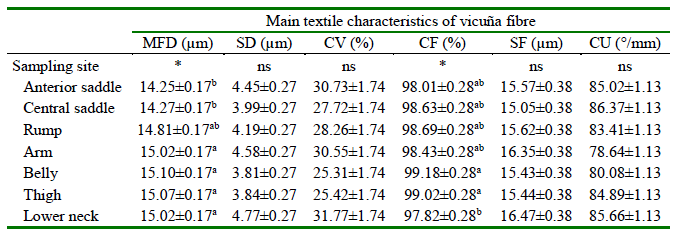
* p<0.05; ns no significant
A significant interaction between dandruff and age we observed in MFD and CV (Table 4). The MFD in adult with dandruff (14.38 µm) and adults without dandruff (15.29 µm) showed a difference of 0.90 µm (p<0.05). The MFD in adults with dandruff resulted finest than in juveniles without dandruff (14.93 µm), also the MFD in adults without dandruff was thicker than in juveniles with dandruff (p<0.05). In vicuñas without dandruff, the literature agrees that MFD in juveniles is lower than in adults (Quispe et al., 2011; Pinares & Yauri, 2019). Regarding the CV, the juvenile with dandruff showed better uniformity (24.76%) compared to juveniles without dandruff (29.75%), in addition, the CV of juveniles with dandruff was lower than the adults with dandruff (29.98%) and adults without dandruff (29.66%).
Table 4 Interactions analysis for mean fibre diameter (MFD), standard deviation of MFD (SD), coefficient of variation of MFD (CV), percentage of fibres <30µm (CF), spinning fineness (SF) and mean curvature (CU) of vicuña fleece

In the interactions of each factor was considered dandruff: presence and absence, sampling site: lower neck, anterior saddle, central saddle, rump, thigh, belly and arm, age: juvenile and adult, sex: female and male.
* p <0.05; ns no significant
The interaction of dandruff and sex was significant in MFD and CV (Table 4). The MFD in females with dandruff showed lower value (14.21 µm) compared to the other groups: females without dandruff (15.15 µm), males without dandruff (15.06 µm) and males with dandruff (14.75 µm), as shown in Figure 4. The CV in males with dandruff showed a lower value (24.70%) compared to females with dandruff (30.04%) and females without dandruff (30.68%). The fibre of juvenile males showed better uniformity (24.50%) respect to juvenile females (30%) and respect to adult females (30.71%). On the other hand, the most affected by dandruff are the adult females (Flores et al., 2021). The interaction between dandruff and age for MFD is showed (Figure 5). Additionally, for MFD there is a significant interaction between dandruff and fleece sampling site, dandruff significantly reduces MFD in the lower neck, anterior and central saddle.
Among the main fibre textile characteristics, positive and negative phenotypic correlations of intermediate to high magnitude were observed. The correlations between MFD with SD, CV and SF were positive and intermediate. In this study, the correlations were high and positive (>0.87) for SD with CV and SF (Table 5), between MFD and SF was 0.60 lower than 0.92 and 0.98 in fibre without dandruff reported by Pinares &Yauri (2019) and Quispe et al. (2011), respectively. There are high negative correlations for CF with SD, CV and SF. Pinares & Yauri (2019) reported similar correlations in vicuña fibre without dandruff.
Table 5 Phenotypic correlations (r) among the six main textile characteristics of vicuña fibre
| MFD | SD | CV | CF | SF | CU | |
|---|---|---|---|---|---|---|
| MFD | 1 | 0.299 | 0.146 | -0.276 | 0.599 | -0.344 |
| <.0001 | 0.020 | <.0001 | <.0001 | <.0001 | ||
| SD | 1 | 0.986 | -0.890 | 0.937 | 0.004 | |
| <.0001 | <.0001 | <.0001 | 0.945 | |||
| CV | 1 | -0.868 | 0.871 | 0.059 | ||
| <.0001 | <.0001 | 0.354 | ||||
| CF | 1 | -0.846 | 0.074 | |||
| <.0001 | 0.244 | |||||
| SF | 1 | -0.113 | ||||
| 0.073 | ||||||
| CI | 1 |
MGD: Standard error of mean fibre diameter; SD: Standard deviation of MFD; CV: Coefficient of variation of MFD; CF: Percentage of fibres <30 µm; SF: Spinning fineness; CI: Curvature index
For each variable, the upper sub-row indicates Pearson's correlation coefficient (r) The bottom sub-row indicates the probability (p-value)
CONCLUSIONS
The prevalence of dandruff in vicuñas of the Community of San Miguel de Mestizas in 2017 was 20.55% and 22.97% in 2021.
Dandruff influences the textile quality of the fibre by reducing the mean fibre diameter, especially in adults than in juveniles and in females than males.
Based on the sampling site dandruff significantly reduces mean fibre diameter in the lower neck, anterior and central saddle.












 uBio
uBio 
